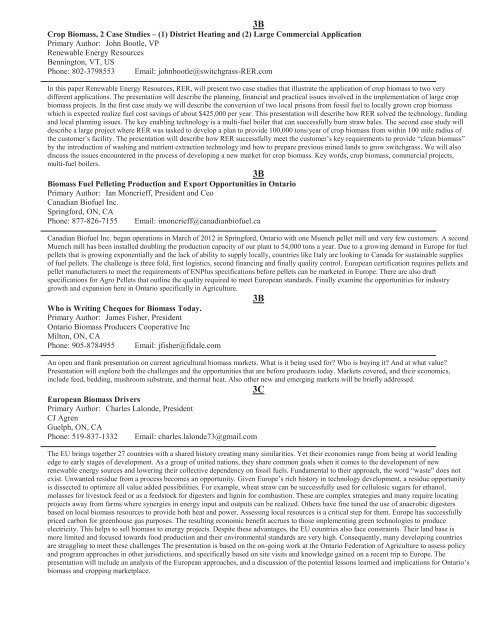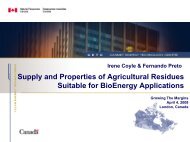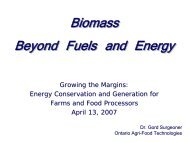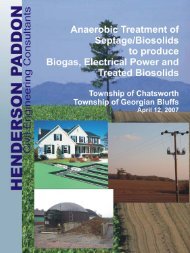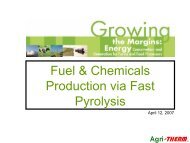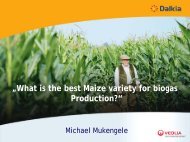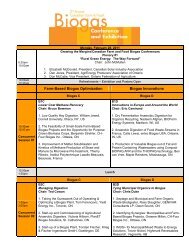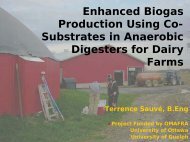Download Conference Program - Green Rural Opportunities Summit ...
Download Conference Program - Green Rural Opportunities Summit ...
Download Conference Program - Green Rural Opportunities Summit ...
You also want an ePaper? Increase the reach of your titles
YUMPU automatically turns print PDFs into web optimized ePapers that Google loves.
3BCrop Biomass, 2 Case Studies – (1) District Heating and (2) Large Commercial ApplicationPrimary Author: John Bootle, VPRenewable Energy ResourcesBennington, VT, USPhone: 802-3798553 Email: johnbootle@switchgrass-RER.comIn this paper Renewable Energy Resources, RER, will present two case studies that illustrate the application of crop biomass to two verydifferent applications. The presentation will describe the planning, financial and practical issues involved in the implementation of large cropbiomass projects. In the first case study we will describe the conversion of two local prisons from fossil fuel to locally grown crop biomasswhich is expected realize fuel cost savings of about $425,000 per year. This presentation will describe how RER solved the technology, fundingand local planning issues. The key enabling technology is a multi-fuel boiler that can successfully burn straw bales. The second case study willdescribe a large project where RER was tasked to develop a plan to provide 100,000 tons/year of crop biomass from within 100 mile radius ofthe customer’s facility. The presentation will describe how RER successfully meet the customer’s key requirements to provide “clean biomass”by the introduction of washing and nutrient extraction technology and how to prepare previous mined lands to grow switchgrass. We will alsodiscuss the issues encountered in the process of developing a new market for crop biomass. Key words, crop biomass, commercial projects,multi-fuel boilers.3BBiomass Fuel Pelleting Production and Export <strong>Opportunities</strong> in OntarioPrimary Author: Ian Moncrieff, President and CeoCanadian Biofuel Inc.Springford, ON, CAPhone: 877-826-7155 Email: imoncrieff@canadianbiofuel.caCanadian Biofuel Inc. began operations in March of 2012 in Springford, Ontario with one Muench pellet mill and very few customers. A secondMuench mill has been installed doubling the production capacity of our plant to 54,000 tons a year. Due to a growing demand in Europe for fuelpellets that is growing exponentially and the lack of ability to supply locally, countries like Italy are looking to Canada for sustainable suppliesof fuel pellets. The challenge is three fold, first logistics, second financing and finally quality control. European certification requires pellets andpellet manufacturers to meet the requirements of ENPlus specifications before pellets can be marketed in Europe. There are also draftspecifications for Agro Pellets that outline the quality required to meet European standards. Finally examine the opportunities for industrygrowth and expansion here in Ontario specifically in Agriculture.3BWho is Writing Cheques for Biomass Today.Primary Author: James Fisher, PresidentOntario Biomass Producers Cooperative IncMilton, ON, CAPhone: 905-8784955 Email: jfisher@fidale.comAn open and frank presentation on current agricultural biomass markets. What is it being used for? Who is buying it? And at what value?Presentation will explore both the challenges and the opportunities that are before producers today. Markets covered, and their economics,include feed, bedding, mushroom substrate, and thermal heat. Also other new and emerging markets will be briefly addressed.3CEuropean Biomass DriversPrimary Author: Charles Lalonde, PresidentCJ AgrenGuelph, ON, CAPhone: 519-837-1332 Email: charles.lalonde73@gmail.comThe EU brings together 27 countries with a shared history creating many similarities. Yet their economies range from being at world leadingedge to early stages of development. As a group of united nations, they share common goals when it comes to the development of newrenewable energy sources and lowering their collective dependency on fossil fuels. Fundamental to their approach, the word “waste” does notexist. Unwanted residue from a process becomes an opportunity. Given Europe’s rich history in technology development, a residue opportunityis dissected to optimize all value added possibilities. For example, wheat straw can be successfully used for cellulosic sugars for ethanol,molasses for livestock feed or as a feedstock for digesters and lignin for combustion. These are complex strategies and many require locatingprojects away from farms where synergies in energy input and outputs can be realized. Others have fine tuned the use of anaerobic digestersbased on local biomass resources to provide both heat and power. Assessing local resources is a critical step for them. Europe has successfullypriced carbon for greenhouse gas purposes. The resulting economic benefit accrues to those implementing green technologies to produceelectricity. This helps to sell biomass to energy projects. Despite these advantages, the EU countries also face constraints. Their land base ismore limited and focused towards food production and their environmental standards are very high. Consequently, many developing countriesare struggling to meet these challenges The presentation is based on the on-going work at the Ontario Federation of Agriculture to assess policyand program approaches in other jurisdictions, and specifically based on site visits and knowledge gained on a recent trip to Europe. Thepresentation will include an analysis of the European approaches, and a discussion of the potential lessons learned and implications for Ontario’sbiomass and cropping marketplace.


